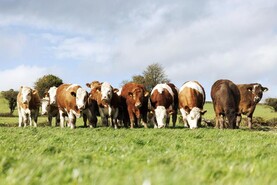Average grass growth rates at the moment are in the mid-50s – which is about normal for the time of year.
These growth rates are more or less equal to demand for grass on most farms. This means that average farm cover is in a state of equilibrium – neither rising nor falling.
However, most farmers should be building covers at this stage. The target is to be at an average farm cover of between 1,000kg/ha and 1,200kg/ha by the end of September.
After this time, growth rates will start to decline sharply, precipitated by declining daylight hours and lower soil temperatures.
Average growth rate in October is down around the mid-30s, which is a big drop from current growth rates.
Build up covers
The objective of building up covers is to have a reserve of grass built up so the herd can eat into this during the autumn and at the same time be able to carry over a bank of grass to next spring.
Peak average farm cover should be at the end of September or early October. How high this peak should be is determined by the farm stocking rate (higher stocking rates need higher covers) and also by the soil type on the farm.
Heavier farms are less suitable to high covers, as they can become a liability in wet weather – difficult to graze and prone to high levels of utilisation losses.
What level to pitch peak covers at on your farm can only be determined after doing an autumn grass budget.
The best method of doing this is through the PastureBase grass measuring programme, as this updates the budget accordingly as new grass covers are completed.
Farmers who are behind target now should be reducing their demand for grass by either selling cull cows or putting in extra supplement.
Read more
The Grass Week: don’t plan for silage in October to stretch grazing season
Ornua index increases for August
Average grass growth rates at the moment are in the mid-50s – which is about normal for the time of year.
These growth rates are more or less equal to demand for grass on most farms. This means that average farm cover is in a state of equilibrium – neither rising nor falling.
However, most farmers should be building covers at this stage. The target is to be at an average farm cover of between 1,000kg/ha and 1,200kg/ha by the end of September.
After this time, growth rates will start to decline sharply, precipitated by declining daylight hours and lower soil temperatures.
Average growth rate in October is down around the mid-30s, which is a big drop from current growth rates.
Build up covers
The objective of building up covers is to have a reserve of grass built up so the herd can eat into this during the autumn and at the same time be able to carry over a bank of grass to next spring.
Peak average farm cover should be at the end of September or early October. How high this peak should be is determined by the farm stocking rate (higher stocking rates need higher covers) and also by the soil type on the farm.
Heavier farms are less suitable to high covers, as they can become a liability in wet weather – difficult to graze and prone to high levels of utilisation losses.
What level to pitch peak covers at on your farm can only be determined after doing an autumn grass budget.
The best method of doing this is through the PastureBase grass measuring programme, as this updates the budget accordingly as new grass covers are completed.
Farmers who are behind target now should be reducing their demand for grass by either selling cull cows or putting in extra supplement.
Read more
The Grass Week: don’t plan for silage in October to stretch grazing season
Ornua index increases for August






 This is a subscriber-only article
This is a subscriber-only article










SHARING OPTIONS: